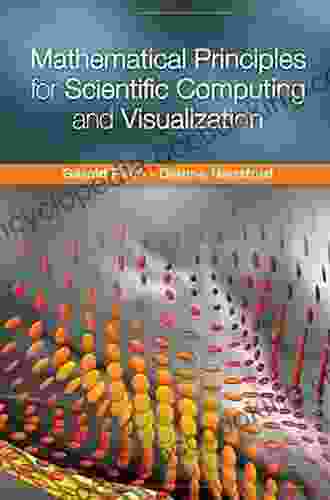Unlocking the Potential: Mathematical Principles for Scientific Computing and Visualization

In the ever-evolving realm of scientific discovery and data analysis, mathematical modeling and visualization play an indispensable role. The book "Mathematical Principles for Scientific Computing and Visualization" serves as a comprehensive guide for scientists, engineers, and researchers seeking to harness the power of mathematical principles to tackle complex scientific problems and create insightful visualizations.
The book establishes a solid foundation in the mathematical principles underpinning scientific computing and visualization. It explores fundamental concepts such as:
- Linear Algebra and Matrix Theory: The mathematics of matrices and vectors, essential for representing and manipulating data in scientific computing.
- Calculus of Variations and Optimization: The theory of maximizing or minimizing functions, useful for solving problems in physics, engineering, and optimization.
- Partial Differential Equations: Equations that describe the behavior of continuous systems, crucial for modeling complex phenomena in science and engineering.
Building upon the mathematical foundations, the book delves into the practical aspects of scientific computing. Readers will learn about:
5 out of 5
| Language | : | English |
| File size | : | 9301 KB |
| Print length | : | 275 pages |
- Numerical Methods: Techniques for approximating solutions to mathematical problems, such as finite difference methods, finite element methods, and Monte Carlo simulations.
- High-Performance Computing: Strategies for leveraging parallel processing and distributed computing to accelerate scientific computations.
- Visualization in Scientific Computing: Techniques for representing and manipulating data visually, including scientific visualization, volume visualization, and interactive visualization.
The book emphasizes the importance of visualization in scientific computing and provides a thorough examination of visualization principles and techniques. Topics covered include:
- Perceptual Psychology of Visualization: The human visual system and how it perceives and interprets visual stimuli.
- Visual Data Analysis: Techniques for extracting insights from complex data sets through visual exploration.
- Visualization Design: Principles for creating effective and informative visualizations.
To demonstrate the practical impact of mathematical principles in scientific computing and visualization, the book presents real-world examples in various scientific and engineering disciplines. These applications showcase how these principles have been successfully employed to:
- Solve complex physical problems: Model fluid dynamics, solid mechanics, and quantum systems.
- Analyze large-scale data: Process and visualize data from fields such as biology, climate science, and social sciences.
- Create immersive visualizations: Generate realistic and interactive simulations for engineering, medicine, and virtual reality applications.
The book offers several key features that make it an invaluable resource for researchers and practitioners in the field:
- Comprehensive coverage: Encompasses the full spectrum of mathematical principles, scientific computing techniques, and visualization principles.
- Rigorous yet accessible: Presents complex concepts in a clear and concise manner, making the book suitable for both advanced students and established professionals.
- Practical orientation: Provides numerous examples and case studies to illustrate the practical applications and benefits of mathematical principles in scientific computing and visualization.
- Up-to-date content: Incorporates the latest advancements in these fields, ensuring readers have the most current knowledge available.
"Mathematical Principles for Scientific Computing and Visualization" is a transformative text that empowers scientists, engineers, and researchers to harness the power of mathematical principles and visualization techniques to unlock the full potential of scientific computing. Its comprehensive coverage, rigorous yet accessible approach, and practical orientation make it an essential resource for anyone seeking to advance their knowledge and skills in this critical field.
5 out of 5
| Language | : | English |
| File size | : | 9301 KB |
| Print length | : | 275 pages |
Do you want to contribute by writing guest posts on this blog?
Please contact us and send us a resume of previous articles that you have written.
 Book
Book Novel
Novel Page
Page Chapter
Chapter Text
Text Story
Story Genre
Genre Reader
Reader Library
Library Paperback
Paperback E-book
E-book Magazine
Magazine Newspaper
Newspaper Paragraph
Paragraph Sentence
Sentence Bookmark
Bookmark Shelf
Shelf Glossary
Glossary Bibliography
Bibliography Foreword
Foreword Preface
Preface Synopsis
Synopsis Annotation
Annotation Footnote
Footnote Manuscript
Manuscript Scroll
Scroll Codex
Codex Tome
Tome Bestseller
Bestseller Classics
Classics Library card
Library card Narrative
Narrative Biography
Biography Autobiography
Autobiography Memoir
Memoir Reference
Reference Encyclopedia
Encyclopedia Abi Palmer
Abi Palmer Aimee Bissonette
Aimee Bissonette Adam Ramirez
Adam Ramirez Adam White
Adam White A Desaint
A Desaint Alan Greenfield
Alan Greenfield Ahmed Riahi Belkaoui
Ahmed Riahi Belkaoui Alan R Hall
Alan R Hall Alex Debogorski
Alex Debogorski Alan Robertson
Alan Robertson Addison Hodges Hart
Addison Hodges Hart Aidan Maccarthy
Aidan Maccarthy Aaron Spulber
Aaron Spulber Adebanji Alade
Adebanji Alade Alane Adams
Alane Adams Adam Blade
Adam Blade Al Roker
Al Roker Alan Shipnuck
Alan Shipnuck Aisha Khalfay
Aisha Khalfay 1st Ed 2021 Edition Kindle Edition
1st Ed 2021 Edition Kindle Edition
Light bulbAdvertise smarter! Our strategic ad space ensures maximum exposure. Reserve your spot today!
 Gilbert CoxFollow ·7.6k
Gilbert CoxFollow ·7.6k Joshua ReedFollow ·12.5k
Joshua ReedFollow ·12.5k Clark CampbellFollow ·19.4k
Clark CampbellFollow ·19.4k Samuel BeckettFollow ·14.2k
Samuel BeckettFollow ·14.2k George OrwellFollow ·11.6k
George OrwellFollow ·11.6k Cooper BellFollow ·12.4k
Cooper BellFollow ·12.4k Al FosterFollow ·8.7k
Al FosterFollow ·8.7k David MitchellFollow ·18.3k
David MitchellFollow ·18.3k

 Francis Turner
Francis TurnerArt and Politics in the Shadow of Music
Music has...

 Jaylen Mitchell
Jaylen MitchellHow Algorithms Are Rewriting The Rules Of Work
The workplace is...

 Chandler Ward
Chandler WardRio de Janeiro & Minas Gerais Footprint Handbooks:...
Embark on an extraordinary adventure through...

 David Mitchell
David MitchellThe Story of Depression: Understanding and Treating a...
Delving into the Shadows of...

 Al Foster
Al FosterStatistics Done Wrong: The Woefully Complete Guide
Tired of being...

 DeShawn Powell
DeShawn PowellJulia Child's Second Act: A Tale of Triumph,...
Julia Child is an...
5 out of 5
| Language | : | English |
| File size | : | 9301 KB |
| Print length | : | 275 pages |












